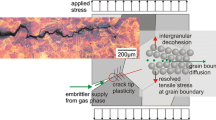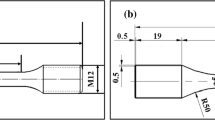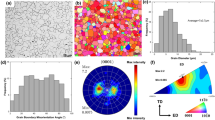Abstract
Polycrystalline copper (99.9%) was fatigued at a total strain amplitude of 0.1 and 0.2%, respectively. The tests were performed in situ under vacuum in a Large Chamber-Scanning Electron Microscope. By a repeated combination of in situ fatigue testing and ex situ focused ion beam milling, a deep insight into the mechanism of fatigue crack initiation and early stages of crack initiation at persistent slip bands (PSBs) and their interaction with grain boundaries was obtained. The EBSD-technique showed early slip activation and the exclusive formation of extrusions in favorably oriented grains until a certain extrusion height was reached. At the total strain amplitude of 0.2%, extrusions are formed not only in favorably oriented grains but also in grains with a lower Schmid factor due to high compatibility stresses at the grain boundaries. Extrusion growth through grain boundaries is affected by the orientation of the primary slip systems in the neighboring grains and the additional anisotropy stresses. It is concluded that early stages of crack initiation are the consequence of the formation of extrusions at PSBs in combination with the clustering of vacancies along the PSB boundaries, as it was proposed by the well-known Essmann-Gösele-Mughrabi model.





Similar content being viewed by others
References
A. Wöhler: Über die Festigkeitsversuche mit Eisen und Stahl. Z. Bauwes. 20, 73 (1870).
J.A. Ewing and J.C. Humphrey: The fracture of metals under repeated alternation of stress. Philos. Trans. R. Soc. London 200, 321 (1903).
P.J.E. Forsyth: Exudation of material from slip bands at the surface of fatigued crystals of an aluminum–copper alloy. Nature 171, 172 (1953).
S.S. Manson: Behavior of materials under conditions of thermal stress. NACA Rep. 1170, 1 (1954). (Supersedes NACA TN 2933 (1953)).
L.F. Coffin: A study of the effects of cyclic thermal stresses on a ductile metal. Trans. ASME 76, 931 (1954).
N. Thompson, N. Wadsworthand, and N. Louat: The origin of fatigue fracture in copper. Philos. Mag. 1–2, 113 (1956).
H. Mughrabi: Dislocations in fatigue. In Dislocations and Properties of Real Materials, Institute of Metals Vol. 323 (The Institute of Metals, London, 1985); p. 244.
P. Paris and F. Erdogan: A critical analysis of crack propagation laws. J. Basic Eng. 85, 528 (1963).
F. Erdogan and G.C. Sih: On the crack extension in plates under plane loading and transverse shear. J. Basic Eng. 85, 519 (1963).
K.T. Faber and A.G. Evans: Crack deflection processes—I. Theory. Acta Metall. 31, 565 (1983).
S. Suresh and R.O. Ritchie: Geometric model for fatigue crack closure induced by fracture surface roughness. Metall. Trans. A 13, 1627 (1982).
K. Tanaka, Y. Nakai, and M. Yamashita: Fatigue growth threshold of small cracks. Int. J. Fract. 17, 519 (1981).
R. Pippan, C. Zelger, E. Gach, C. Bichler, and H. Weinhandl: On the mechanism of fatigue crack propagation in ductile metallic materials. Fatigue Fract. Eng. Mater. Struct. 34, 1 (2010).
P. Lukáš, M. Klesnil, and J. Krejčí: Dislocations and persistent slip bands in copper single crystals fatigued at low stress amplitude. Phys. Status Solidi B 27, 545 (1968).
P. Lukáš and M. Klesnil: Dislocation structures in fatigued single crystals of Cu–Zn system. Phys. Status Solidi A 5, 247 (1971).
H. Mughrabi: The cyclic hardening and saturation behaviour of copper single crystals. Mater. Sci. Eng. 33, 207 (1978).
U. Essmann, U. Gösele, and H. Mughrabi: A model of extrusions and intrusions in fatigued metals I. Point-defect production and the growth of extrusions. Philos. Mag. A 44, 405 (1981).
C.E. Feltner and C. Laird: The role of slip character in steady state cyclic stress–strain behavior. Trans. TMS-AIME 245, 1372 (1969).
R. Wang and H. Mughrabi: Cyclic deformation of face-centred polycrystals: A comparison with observations on single crystals. In Deformation of Polycrystals: Mechanisms and Microstructures: Proceedings of the 2nd Risø International Symposium on Metallurgy and Materials Science, N. Hansen and D.K. Riso, eds. (1981); p. 87.
R. Wang, H. Mughrabi, S. McGovern, and M. Rapp: Fatigue of copper single crystals in vacuum and in air I: Persistent slip bands and dislocation microstructures. Mater. Sci. Eng. 65, 219 (1984).
P. Lukas and L. Kunz: Role of persistent slip bands in fatigue. Philos. Mag. 84 (3–5), 317 (2004).
H. Mughrabi, F. Ackermann, and K. Herz: Fatigue mechanisms. In ASTM Special Technical Publication 675, J.T. Fong, ed. (ASTM, Philadelphia, 1978); p. 69.
P. Neumann: Fatigue. In Physical Metallurgy, 3rd ed., R.W. Cahn and P. Haasen, eds. (Elsevier, Amsterdam, 1983); part 2, p. 1554.
Z.S. Basinski and S.J. Basinski: Low amplitude fatigue of copper single crystals—II. Surface observations. Acta Metall. 33, 1307 (1985).
C. Laird, P. Charsely, and H. Mughrabi: Low energy dislocation structures produced by cyclic deformation. Mater. Sci. Eng. 81, 433 (1986).
J. Bach, J.J. Möller, M. Göken, E. Bitzek, and H.W. Höppel: On the transition from plastic deformation to crack initiation in the high- and very high-cycle fatigue regimes in plain carbon steels. Int. J. Fatigue 93, 281 (2016).
H. Mughrabi, M. Bayerlein, and R. Wang: Direct measurement of the rate of extrusion growth in fatigued copper mono- and polycrystals. In Proceedings of 9th International Conference on Strength of Materials ICSMA-9, D.G. Brandon, R. Chaim, and A. Rosen, eds. (Freund Publishing Company Ltd., London, 1991); p. 879.
H. Mughrabi: Cyclic slip irreversibilities and the evolution of fatigue damage. Metall. Mater. Trans. A 40, 1257 (2009).
H. Mughrabi: Damage mechanisms and fatigue lives: From the low to the very high cycle fatigue regime. Procedia Eng. 55, 636 (2013).
J. Man, M. Petrenec, K. Obrtlík, and J. Polak: AFM and TEM study of cyclic slip localization in fatigued ferritic X10CrAl24 stainless steel. Acta Mater. 52, 5551 (2004).
R. Wang and H. Mughrabi: Fatigue of copper single crystals in vacuum and in air II: Fatigue crack propagation. Mater. Sci. Eng. 65, 235 (1984).
P. Neumann: New experiments concerning the slip processes at propagating fatigue cracks. Acta Metall. 22, 1155 (1974).
G. Dörr and C. Blochwitz: Microcracks in fatigued FCC polycrystals by interaction between persistent slip bands and grain boundaries. Cryst. Res. Technol. 22, 113 (1987).
P. Neumann and A. Tönnessen: Crack initiation at grain boundaries in f.c.c. materials. In Strength of Metals and Alloys (ICSMA 8), P.O. Kettunen, T.K. Lepistö, and M.E. Lehtonen, eds. (Pergamon, Oxford, 1989); p. 743.
J. Man, T. Vystavěl, A. Weidner, I. Kuběna, M. Petrenec, T. Kruml, and J. Polák: Study of cyclic strain localization and fatigue crack initiation using FIB-technique. Int. J. Fatigue 39, 44 (2012).
K. Tanaka and T. Mura: A dislocation model for fatigue crack initiation. J. Appl. Mech. 48, 97 (1981).
T. Mura and Y. Nakasone: A theory of fatigue crack initiation in solids. J. Appl. Mech. 57, 1 (1990).
K. Differt, U. Esmann, and H. Mughrabi: A model of extrusions and intrusions in fatigued metals II. Surface roughening by random irreversible slip. Philos. Mag. A 54, 237 (1986).
J. Polák: On the role of point defects in fatigue crack initiation. Mater. Sci. Eng. 92, 71 (1987).
J. Polák and J. Man: Fatigue crack initiation—The role of point defects. Int. J. Fatigue 65, 18 (2014).
D. Stalling, M. Westerhoff, and H-C. Hege: Amira: A highly interactive system for visual data analysis. In The Visualization Handbook, C.D. Hansen and C.R. Johnson, eds. (Elsevier, Amsterdam, 2005); p. 749.
E. Schmid and W. Boas: Plasticity of Crystals with Special Reference to Metals (Springer US, Halsted Press, New York, USA, 1968).
J. Polák, J. Man, T. Vystavěl, and M. Petrenec: The shape of extrusions and intrusions and initiation of stage I fatigue cracks. Mater. Sci. Eng., A 517, 204 (2009).
A. Weidner, R. Beyer, C. Blochwitz, C. Holste, A. Schwab, and W. Tirschler: Slip activity of persistent slip bands in polycrystalline nickel. Mater. Sci. Eng., A 435–436, 540 (2006).
A. Weidner and W. Skrotzki: Cyclic slip activity of PSBs in bulk and surface grains. Int. J. Fatigue 32, 851 (2010).
H. Mughrabi and R. Wang: Cyclic stress–strain response and high-cycle fatigue behaviour of copper polycrystals. In Basic Mechanisms in Fatigue, P. Lukáš and J. Polák, eds. (Academia/Elsevier, Amsterdam, 1988); p. 1.
J. Man, P. Klapetek, O. Man, A. Weidner, K. Obrtlík, and J. Polák: Extrusions and intrusions in fatigued metals. Part 2. AFM and EBSD study of the early growth of extrusions and intrusions in 316L steel fatigued at room temperature. Philos. Mag. 89, 1337 (2009).
R. Zauter, F. Petry, M. Bayerlein, C. Sommer, H.J. Christ, and H. Mughrabi: Electron channelling contrast as a supplementary method for microstructural investigations in deformed metals. Philos. Mag. A 66, 425 (1992).
J. Ahmed, A.J. Wilkinson, and S.G. Roberts: Electron channeling contrast imaging characterization of dislocation structures associated with extrusion and intrusion systems and fatigue cracks in copper single crystals. Philos. Mag. A 81, 1473 (2001).
A. Schwab, J. Bretschneider, C. Buque, C. Blochwitz, and C. Holste: Application of electron channelling contrast to the investigation of strain localization effects in cyclically deformed fcc crystals. Philos. Mag. Lett. 74, 449 (1996).
A. Weidner, C. Blochwitz, W. Skrotzki, and W. Tirschler: Formation of slip steps and growth of extrusions within persistent slip bands in cyclically deformed polycrystals. Mater. Sci. Eng., A 479, 181 (2008).
K. Mecke and C. Blochwitz: Internal displacements of persistent slip bands in cyclically deformed nickel single crystals. Phys. Status Solidi A 61, K5 (1980).
H.W. Höppel, Z.M. Zhou, H. Mughrabi, and R.Z. Valiev: Microstructural study of the parameters governing coarsening and cyclic softening in fatigued ultrafine-grained copper. Philos. Mag. A 82, 1781 (2002).
L.M. Brown and S.L. Ogin: Role of internal stresses in the nucleation of fatigue cracks. In Fundamentals of Deformation and Fracture, J.R. Willis, B.A. Bilby, and K.J. Miller, eds. (Eshelby Memorial Symposium, Cambridge University Press, Cambridge, 1984); p. 501.
S. Brinckmann and E. Van der Giessen: A discrete dislocation dynamics study aiming at understanding fatigue crack initiation. Mater. Sci. Eng., A 387–389, 461 (2004).
J. Polák: Mechanisms and kinetics of the early fatigue damage in crystalline materials. Mater. Sci. Eng., A 468–470, 33–39 (2007).
A. Heinz and P. Neumann: Crack initiation during high cycle fatigue of an austenitic steel. Acta Metall. Mater. 38, 1933 (1990).
L.L. Li, P. Zhang, Z.J. Zhang, H.F. Zhou, S.X. Qu, J.B. Yang, and Z.F. Zhang: Strain localization and fatigue cracking behaviors of Cu bicrystal with an inclined twin boundary. Acta Metall. Mater. 73, 167 (2014).
Z.J. Zhang, P. Zhang, L.L. Li, and Z.F. Zhang: Fatigue cracking at twin boundaries: Effects of crystallographic orientation and stacking fault energy. Acta Metall. Mater. 60, 3113 (2012).
ACKNOWLEDGMENTS
The authors like to greatly acknowledge the funding by the German Research Council (DFG) within the scope of project Go741/23-2. The authors also gratefully acknowledge the funding of the DFG which, within the framework of its “Excellence Initiative”, supports the Cluster of Excellence “Engineering of Advanced Materials” at the University of Erlangen-Nürnberg.
Author information
Authors and Affiliations
Corresponding author
Additional information
Dedicated to Prof. Dr. Haël Mughrabi on the occasion of his 80th birthday.
This author was an editor of this journal during the review and decision stage. For the JMR policy on review and publication of manuscripts authored by editors, please refer to http://www.mrs.org/editor-manuscripts/.
Rights and permissions
About this article
Cite this article
Höppel, H.W., Goik, P., Krechel, C. et al. Ex and in situ investigations on the role of persistent slip bands and grain boundaries in fatigue crack initiation. Journal of Materials Research 32, 4276–4286 (2017). https://doi.org/10.1557/jmr.2017.313
Received:
Accepted:
Published:
Issue Date:
DOI: https://doi.org/10.1557/jmr.2017.313




